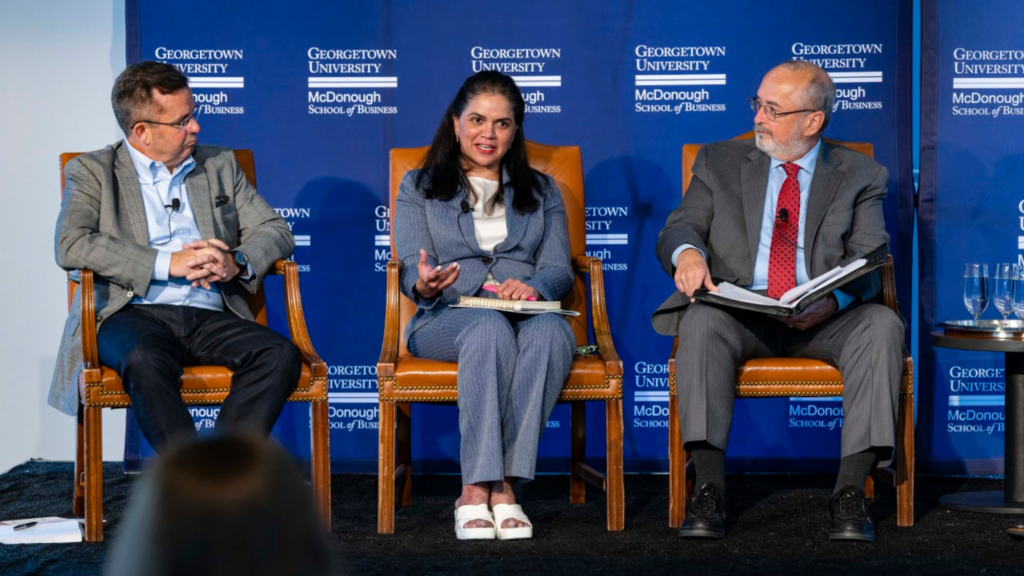Business for Impact Proposes Solutions to Nationwide Medical Debt Crisis
For many working families across the country, healthcare expenses and medical bills are oftentimes stressors that continue to pile up with no end in sight – especially for those who are in need of ongoing medical attention or are dealing with an unexpected illness.
Medical debt puts millions of people at risk for economic and health problems, and according to studies, nearly one-third have avoided or delayed care as a result of their medical debt burden. With the goal of mitigating these issues, Business for Impact at Georgetown University’s McDonough School of Business hosted a forum September 8, with support from Capio Partners, LLC, to examine possible solutions to this nationwide problem.
The forum discussed the findings of a newly released report, Prescription For Medical Debt: How Care Providers, Collection Agencies and Government Can Help, which details the key contributors to the issues of medical debt: high deductible plans, expensive out-of-pocket costs, price variations, and health system provider miscommunications, along with other inefficiencies. Notably, the report introduces the concept of Asset Limited, Income Constrained, and Employed (ALICE) families, which is a segment of the population that is disproportionately affected by the constraints of medical debt. By addressing medical debt and making healthcare more affordable for ALICE Families, the report shares the potential for systemic change to the ongoing medical debt and healthcare crisis.

The event convened experts from across industry sectors, including Hank Cardello, executive director for Leadership Solutions for Health + Prosperity at Business for Impact; John McNamara, assistant director of consumer credit, payments, and deposits markets, Division of Research, Markets, and Regulations, Consumer Financial Protection Bureau; Ashwini Kotwal, CEO of Arietis Health; and Mark Detrick, CEO of Capio, LLC.
During the event, Cardello spoke about the significance of various sectors working in conjunction with one another to prevent further medical debt for people across the country and how there are direct benefits for society as a whole in doing so.
“Helping families get out from under medical debt and avoid it in the future would help improve their immediate outcomes,” said Cardello. “It’s also in the best interest of employers, health systems, insurers, and collection agencies to be working together to help eradicate this debt for families.”
Panelists made several recommendations to improve medical debt strain for families, which ranged from encouraging more widely available educational opportunities surrounding the topic of medical debt to increased employer involvement on the issue and legislative action.
During the panel conversation, McNamara spoke about the findings of the Consumer Financial Protection Bureau’s curated research, which calls attention to certain communities that are most at risk of medical debt burdens and the impact it has on their everyday lives.
“We found that there were there were roughly eighty-eight billion dollars in medical debt on credit reports, and we discovered that these debt collection trade lines are disproportionately marking up the credit reports of Black and Hispanic consumers and low-income consumers,” said McNamara. “If you tried to get a mortgage, and you were Black, you were more likely to have one of these debt collection trade lines, and you may have paid the price, which is an awful thought. And then we saw regional differences, too, and states that didn’t expand Medicare disproportionately.”
During the conversation, Kotwal explained that many of these systemic problems are created from a lack of vital conversation between providers and patients at the beginning of a treatment plan.
“No one engages with the patient early on to tell them exactly what is going on. It’s the consumer who suffers,” said Kotwal. “The doctors actually do not know the policy and cannot determine if you are uninsured at the time of service – these are things that never get discussed because the doctor is there to treat you and look at your condition. Hospitals are not equipped to deal with these issues at the moment. Many things can change this, but this is currently what the issues are at the micro level.”
From a policy standpoint, the report states that legislators should set a certain percentage of income rule for monthly repayments and consider a bill to subsidize medical debt repayment for at-risk households. The report also identified increasing access to collections professionals as one of the primary methods to help patients understand what they owe, leverage more flexible repayment options, and access counseling for planning future medical expenses.
“What I think it would make a big difference is more things like what we’re doing today,” said Detrick. “The ability to collaborate with people from different perspectives who are all trying to address medical debt is critical. We might have some different ideas, we might not agree on everything, but I think that through these conversations we will start to see some common ground and incrementally do some things that can make a difference in the long run.”
Watch the panel discussion on YouTube, and follow Business for Impact on Twitter, Facebook, and Instagram for upcoming events.
- Tagged
- Business for Impact
